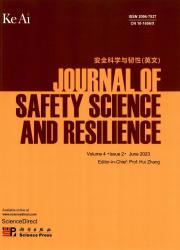基于扩展xLSTM网络的城市道路塌陷风险评估
IF 3.4
Q1 PUBLIC, ENVIRONMENTAL & OCCUPATIONAL HEALTH
引用次数: 0
摘要
快速城市化大大增加了城市地下空间的复杂性。这种复杂性导致道路坍塌事件频繁发生,对城市居民的安全和财产构成重大威胁。因此,早期进行道路塌陷风险评估的准确方法对于预防这些事件和应急准备至关重要。在本研究中,收集了中国南方城市广东省佛山市2016-2021年的道路塌陷事件数据。利用Sentinel-1卫星的InSAR时间序列数据,生成地面沉降图,并构建可公开访问的基于地面沉降趋势的城市道路塌陷风险数据集(GSTURCRD)。提出了一种基于扩展长短期记忆(xLSTM)网络的城市道路塌陷风险评估方法。该方法引入了两种新的LSTM变体,标量LSTM (sLSTM)和矩阵LSTM (mLSTM),结合了指数门控和创新的矩阵存储结构。这些变体使用剩余连接进行集成,形成一个全面的网络架构,能够有效地学习和表示时间特征。数据集的实验结果表明,该方法在评估能力方面明显优于原始LSTM网络和传统机器学习方法(准确率为0.886,召回率为0.857)。最后,通过对佛山实际事故的分析,验证了该方法的有效性;因此,它能够对城市地区的高风险路段进行准确和及时的探测并提供早期预警。本文章由计算机程序翻译,如有差异,请以英文原文为准。
Urban road collapse risk assessment based on the extended xLSTM Network
Rapid urbanization has substantially increased the complexity of urban underground spaces. This complexity leads to frequent road collapse incidents that pose significant threats to the safety and property of urban residents. Therefore, accurate methods of performing early road collapse risk assessments are crucial for preventing these incidents and emergency preparedness. In this study, road collapse incident data for 2016–2021 were collected for Foshan, Guangdong Province, a city in southern China. Utilizing InSAR time-series data from Sentinel-1 satellites, ground subsidence maps were generated, and the publicly accessible Ground Subsidence Trend-Based Urban Road Collapse Risk Dataset (GSTURCRD) was constructed. A novel risk assessment method for urban road collapse based on an extended long short-term memory (xLSTM) network was proposed. This method introduces two new LSTM variants, the scalar LSTM (sLSTM) and the matrix LSTM (mLSTM), incorporating exponential gating and an innovative matrix memory structure. These variants are integrated using residual connections to form a comprehensive network architecture that enables effective learning and representation of the temporal features. The experimental results from the dataset demonstrate that the proposed method significantly outperforms the original LSTM network and traditional machine learning methods regarding assessment capability (its accuracy was 0.886, and its recall was 0.857). Furthermore, the method's effectiveness was validated by an analysis of actual incidents that occurred in Foshan; thus, its ability to generate accurate and timely detections and provide early warnings for high-risk road sections in urban areas was confirmed.
求助全文
通过发布文献求助,成功后即可免费获取论文全文。
去求助
来源期刊

安全科学与韧性(英文)
Management Science and Operations Research, Safety, Risk, Reliability and Quality, Safety Research
CiteScore
8.70
自引率
0.00%
发文量
0
审稿时长
72 days
 求助内容:
求助内容: 应助结果提醒方式:
应助结果提醒方式:


